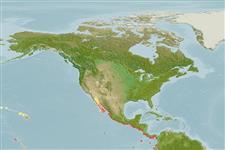Common names from other countries
>
Carangaria/misc (Various families in series Carangaria) >
Centropomidae (Snooks)
Etymology: Centropomus: Greek, kentron = sting + Greek, poma, -atos = cover, operculum (Ref. 45335).
More on author: Günther.
Environment: milieu / climate zone / depth range / distribution range
Écologie
marin; eau douce; saumâtre démersal. Tropical; 29°N - 0°N, 113°W - 77°W
Eastern Pacific: southwestern coast of Baja California Sur, Mexico and the central Gulf of California to Ecuador.
Taille / Poids / Âge
Maturity: Lm ? range ? - ? cm
Max length : 65.0 cm TL mâle / non sexé; (Ref. 55763); common length : 30.0 cm TL mâle / non sexé; (Ref. 55763); poids max. publié: 3.2 kg (Ref. 40637)
Body slender and not very deep; dorsal profile slightly concave behind the eyes; lateral line extending to posterior edge of caudal fin; second anal spine, when folded down, not reaching origin of caudal fin; pectoral fins shorter than pelvic fins; anal fin with 7 rays; back blue or gray; belly silvery; lateral line dark. Membranes between second and third anal spines black; distal quarter of pelvic fins generally dark (Ref. 55763).
Adults inhabit bays and estuaries (Ref. 37955). Also found in high altitudes of at least 250 m elevation and a distance of some 20 km from the coast. They also occur in coastal waters, but is more abundant in estuaries of any size. Enter freshwaters mostly in large rivers and feeds on fish and crustaceans (Ref. 36880).
Life cycle and mating behavior
Maturité | Reproduction | Frai | Œufs | Fécondité | Larves
Bussing, W.A., 1995. Centropomidae. Róbalos. p. 987-995. In W. Fischer, F. Krupp, W. Schneider, C. Sommer, K.E. Carpenter and V. Niem (eds.) Guia FAO para Identification de Especies para lo Fines de la Pesca. Pacifico Centro-Oriental. 3 Vols. FAO, Rome. (Ref. 9284)
Statut dans la liste rouge de l'IUCN (Ref. 130435)
CITES (Ref. 128078)
Not Evaluated
Menace pour l'homme
Harmless
Utilisations par l'homme
Pêcheries: commercial; pêche sportive: oui
Plus d'informations
Noms communsSynonymesMétabolismePrédateursÉcotoxicologieReproductionMaturitéFraiFéconditéŒufsDéveloppement de l'œuf
RéférencesAquacultureProfil d'aquacultureSouchesGénétiqueElectrophoresesHéritabilitéPathologiesTraitementMass conversion
CollaborateursImagesStamps, Coins Misc.SonsCiguateraVitesseType de nageSurface branchialeOtolithesCerveauxVision
Outils
Articles particuliers
Télécharger en XML
Sources Internet
Estimates based on models
Preferred temperature (Ref.
115969): 23.3 - 28.6, mean 27.5 (based on 36 cells).
Phylogenetic diversity index (Ref.
82804): PD
50 = 0.5005 [Uniqueness, from 0.5 = low to 2.0 = high].
Bayesian length-weight: a=0.00741 (0.00464 - 0.01185), b=3.04 (2.90 - 3.18), in cm Total Length, based on LWR estimates for this species & Genus-body shape (Ref.
93245).
Niveau trophique (Ref.
69278): 4.0 ±0.65 se; based on food items.
Résilience (Ref.
120179): Milieu, temps minimum de doublement de population : 1,4 à 4,4 années (Preliminary K or Fecundity.).
Fishing Vulnerability (Ref.
59153): Moderate to high vulnerability (46 of 100).
